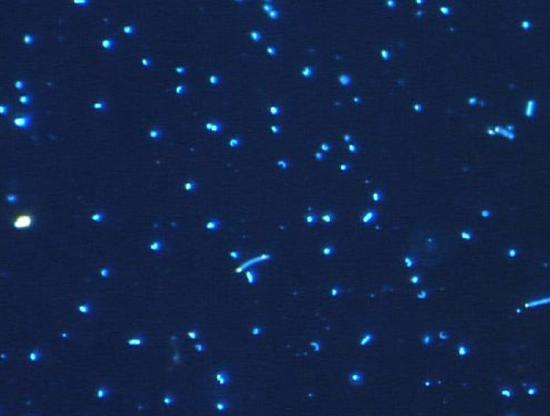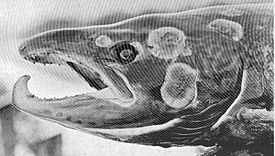Kingdoms of Life in the Ocean
- Page ID
- 976
\( \newcommand{\vecs}[1]{\overset { \scriptstyle \rightharpoonup} {\mathbf{#1}} } \)
\( \newcommand{\vecd}[1]{\overset{-\!-\!\rightharpoonup}{\vphantom{a}\smash {#1}}} \)
\( \newcommand{\id}{\mathrm{id}}\) \( \newcommand{\Span}{\mathrm{span}}\)
( \newcommand{\kernel}{\mathrm{null}\,}\) \( \newcommand{\range}{\mathrm{range}\,}\)
\( \newcommand{\RealPart}{\mathrm{Re}}\) \( \newcommand{\ImaginaryPart}{\mathrm{Im}}\)
\( \newcommand{\Argument}{\mathrm{Arg}}\) \( \newcommand{\norm}[1]{\| #1 \|}\)
\( \newcommand{\inner}[2]{\langle #1, #2 \rangle}\)
\( \newcommand{\Span}{\mathrm{span}}\)
\( \newcommand{\id}{\mathrm{id}}\)
\( \newcommand{\Span}{\mathrm{span}}\)
\( \newcommand{\kernel}{\mathrm{null}\,}\)
\( \newcommand{\range}{\mathrm{range}\,}\)
\( \newcommand{\RealPart}{\mathrm{Re}}\)
\( \newcommand{\ImaginaryPart}{\mathrm{Im}}\)
\( \newcommand{\Argument}{\mathrm{Arg}}\)
\( \newcommand{\norm}[1]{\| #1 \|}\)
\( \newcommand{\inner}[2]{\langle #1, #2 \rangle}\)
\( \newcommand{\Span}{\mathrm{span}}\) \( \newcommand{\AA}{\unicode[.8,0]{x212B}}\)
\( \newcommand{\vectorA}[1]{\vec{#1}} % arrow\)
\( \newcommand{\vectorAt}[1]{\vec{\text{#1}}} % arrow\)
\( \newcommand{\vectorB}[1]{\overset { \scriptstyle \rightharpoonup} {\mathbf{#1}} } \)
\( \newcommand{\vectorC}[1]{\textbf{#1}} \)
\( \newcommand{\vectorD}[1]{\overrightarrow{#1}} \)
\( \newcommand{\vectorDt}[1]{\overrightarrow{\text{#1}}} \)
\( \newcommand{\vectE}[1]{\overset{-\!-\!\rightharpoonup}{\vphantom{a}\smash{\mathbf {#1}}}} \)
\( \newcommand{\vecs}[1]{\overset { \scriptstyle \rightharpoonup} {\mathbf{#1}} } \)
\( \newcommand{\vecd}[1]{\overset{-\!-\!\rightharpoonup}{\vphantom{a}\smash {#1}}} \)
\(\newcommand{\avec}{\mathbf a}\) \(\newcommand{\bvec}{\mathbf b}\) \(\newcommand{\cvec}{\mathbf c}\) \(\newcommand{\dvec}{\mathbf d}\) \(\newcommand{\dtil}{\widetilde{\mathbf d}}\) \(\newcommand{\evec}{\mathbf e}\) \(\newcommand{\fvec}{\mathbf f}\) \(\newcommand{\nvec}{\mathbf n}\) \(\newcommand{\pvec}{\mathbf p}\) \(\newcommand{\qvec}{\mathbf q}\) \(\newcommand{\svec}{\mathbf s}\) \(\newcommand{\tvec}{\mathbf t}\) \(\newcommand{\uvec}{\mathbf u}\) \(\newcommand{\vvec}{\mathbf v}\) \(\newcommand{\wvec}{\mathbf w}\) \(\newcommand{\xvec}{\mathbf x}\) \(\newcommand{\yvec}{\mathbf y}\) \(\newcommand{\zvec}{\mathbf z}\) \(\newcommand{\rvec}{\mathbf r}\) \(\newcommand{\mvec}{\mathbf m}\) \(\newcommand{\zerovec}{\mathbf 0}\) \(\newcommand{\onevec}{\mathbf 1}\) \(\newcommand{\real}{\mathbb R}\) \(\newcommand{\twovec}[2]{\left[\begin{array}{r}#1 \\ #2 \end{array}\right]}\) \(\newcommand{\ctwovec}[2]{\left[\begin{array}{c}#1 \\ #2 \end{array}\right]}\) \(\newcommand{\threevec}[3]{\left[\begin{array}{r}#1 \\ #2 \\ #3 \end{array}\right]}\) \(\newcommand{\cthreevec}[3]{\left[\begin{array}{c}#1 \\ #2 \\ #3 \end{array}\right]}\) \(\newcommand{\fourvec}[4]{\left[\begin{array}{r}#1 \\ #2 \\ #3 \\ #4 \end{array}\right]}\) \(\newcommand{\cfourvec}[4]{\left[\begin{array}{c}#1 \\ #2 \\ #3 \\ #4 \end{array}\right]}\) \(\newcommand{\fivevec}[5]{\left[\begin{array}{r}#1 \\ #2 \\ #3 \\ #4 \\ #5 \\ \end{array}\right]}\) \(\newcommand{\cfivevec}[5]{\left[\begin{array}{c}#1 \\ #2 \\ #3 \\ #4 \\ #5 \\ \end{array}\right]}\) \(\newcommand{\mattwo}[4]{\left[\begin{array}{rr}#1 \amp #2 \\ #3 \amp #4 \\ \end{array}\right]}\) \(\newcommand{\laspan}[1]{\text{Span}\{#1\}}\) \(\newcommand{\bcal}{\cal B}\) \(\newcommand{\ccal}{\cal C}\) \(\newcommand{\scal}{\cal S}\) \(\newcommand{\wcal}{\cal W}\) \(\newcommand{\ecal}{\cal E}\) \(\newcommand{\coords}[2]{\left\{#1\right\}_{#2}}\) \(\newcommand{\gray}[1]{\color{gray}{#1}}\) \(\newcommand{\lgray}[1]{\color{lightgray}{#1}}\) \(\newcommand{\rank}{\operatorname{rank}}\) \(\newcommand{\row}{\text{Row}}\) \(\newcommand{\col}{\text{Col}}\) \(\renewcommand{\row}{\text{Row}}\) \(\newcommand{\nul}{\text{Nul}}\) \(\newcommand{\var}{\text{Var}}\) \(\newcommand{\corr}{\text{corr}}\) \(\newcommand{\len}[1]{\left|#1\right|}\) \(\newcommand{\bbar}{\overline{\bvec}}\) \(\newcommand{\bhat}{\widehat{\bvec}}\) \(\newcommand{\bperp}{\bvec^\perp}\) \(\newcommand{\xhat}{\widehat{\xvec}}\) \(\newcommand{\vhat}{\widehat{\vvec}}\) \(\newcommand{\uhat}{\widehat{\uvec}}\) \(\newcommand{\what}{\widehat{\wvec}}\) \(\newcommand{\Sighat}{\widehat{\Sigma}}\) \(\newcommand{\lt}{<}\) \(\newcommand{\gt}{>}\) \(\newcommand{\amp}{&}\) \(\definecolor{fillinmathshade}{gray}{0.9}\)Most scientists agree that five kingdoms of life exist on Earth: animal, plant, bacteria, fungi and protist. And just as all five can be found across the continents, they exist and flourish in the sea as well. Here, life is adapted to various hazards including temperature, pressure, darkness, and salinity. The greatest depths are where the plant kingdom begins to show itself less while the other kingdoms exist in a quiet dark stillness. Their network of interactions changes with each type of ocean environment and results in a colorful diversity in life throughout the oceans.
Protista
Protists are single-celled or multicellular eukaryotic organisms, meaning they possess membrane-bounded nuclei. Protists cannot be classified as plants, animals, or fungi. They are found anywhere containing liquid water and exist in the oceans as plankton. Being phototrophs and organotrophs, marine protists provide a food source for the upper levels of the oceanic food web. Familiar marine protists include:
- red algae
- dinoflagellates
- diatoms
- euglena

Protists: Courtesy of UMD
Bacteria
Bacteria are single-celled organisms lacking membrane-bound nuclei. They are found all throughout the water column, some being aerobic and some anaerobic. They exist in the water, in sediment, and of course, in many organisms throughout the ocean. Marine bacteria play different roles when comparing with bacteria in other habitats. Some marine organisms harbor light-emitting bacteria, which forms a symbiotic relationship working to create an effect called bioluminescence, and the light produced could be used to hunt prey, defend against predators, and also find mates1. Other bacteria, like cyanobacteria, photosynthesize and are said to be the original source of oxygen on the early planet. They build stromalites, which also provide scientists with a key piece of evidence as to the Earth's past geological history. In addition to that, deep-sea bacteria that thrive on minerals from hydrothermal vents also develop important relationships with the surrounding communities, such as providing essential food sources.

Marine Bacteria: Courtesy of UCSB
Fungi
Marine fungi mainly have continental origins, many being transported out to sea by drifting organic matter from land. They exist largely as parasites on the other kingdoms of life. They can be found living within sand grains, inside coral, and in/outside plants and animals. Many marine fungi have been found to originate from mangrove swamps in which floating pieces of driftwood harbor fungi that may disperse down the water column. Examples include:
- Rhyzophydium littoreum
- Arthopyrenia halodytes
- Fusarium
- Candida albicans

Salmon with fungal disease: Courtesy of Wikipedia
Plants
Underwater plants adapted to higher levels of salinity and some pressure are found all throughout the upper ocean. Here, plants are adapted in similar ways to their terrestrial counterparts. Both have developed ways to hold fast to their supports; one for wind, and one for currents. Whereas trees must grow tall to reach light, some plants develop air sacs to reach the sun. Plants exist in all shapes and sizes in the ocean ranging from the largest kelp to the phytoplankton found throughout the sea that generate a majority of the planet's oxygen.

California Kelp Forest: Courtesy of UCSB
Animals
The most visible kingdom of life in the oceans is the animal kingdom. Marine animals are adapted to a variety of hardships at all ranges across the ocean. The main food web lies between members of the animal kingdom, where the other kingdoms function mainly as food sources or recyclers. Marine animals are both predators and herbivores, creating a complex diversity in the way ecosystems must interact to sustain themselves.

Blacktip Reef Shark, Courtesy of Tracking Sharks
1.education.nationalgeographic....scence/?ar_a=1

